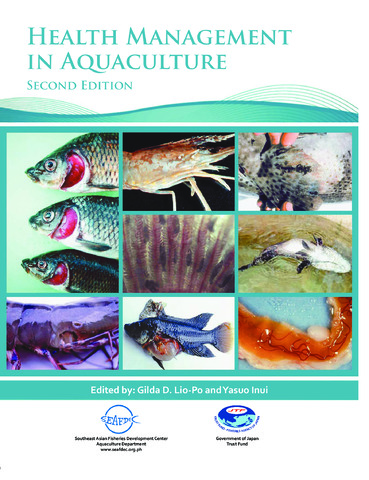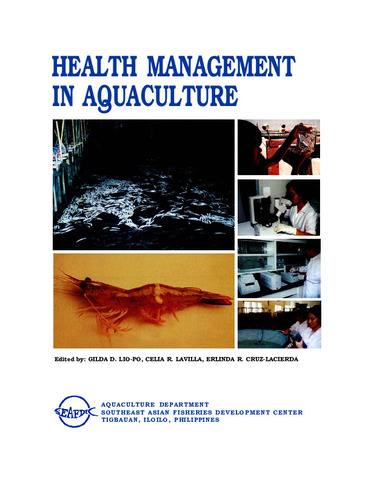| dc.contributor.author | Leaño, Eduardo M. | |
| dc.contributor.editor | Pakingking Jr., Rolando V. | |
| dc.contributor.editor | de Jesus-Ayson, Evelyn Grace T. | |
| dc.contributor.editor | Acosta, Belen O. | |
| dc.date.accessioned | 2016-12-06T07:55:50Z | |
| dc.date.available | 2016-12-06T07:55:50Z | |
| dc.date.issued | 2016 | |
| dc.identifier.citation | Leaño, E. M. (2016). Regional response on AHPND and other emerging shrimp diseases in the Asia-Pacific. In R. V. Pakingking Jr., E. G. T. de Jesus-Ayson, & B. O. Acosta (Eds.), Addressing Acute Hepatopancreatic Necrosis Disease (AHPND) and Other Transboundary Diseases for Improved Aquatic Animal Health in Southeast Asia: Proceedings of the ASEAN Regional Technical Consultation on EMS/AHPND and Other Transboundary Diseases for Improved Aquatic Animal Health in Southeast Asia, 22-24 February 2016, Makati City, Philippines (pp. 24-32). Tigbauan, Iloilo, Philippines: Aquaculture Department, Southeast Asian Fisheries Development Center. | en |
| dc.identifier.isbn | 9789719931065 | |
| dc.identifier.uri | http://hdl.handle.net/10862/3085 | |
| dc.description.abstract | Transboundary aquatic animal diseases are among the major concerns for establishing biosecurity measures and strengthening of aquatic animal health (AAH) management capacity (including emergency preparedness) in the region. In aquaculture, biosecurity and AAH management entails protection of fish or shellfish from infectious agents (viral, bacterial, fungal or parasitic) as well as prevention of disease spread from one area to another. Several transboundary aquatic animal diseases have swept the region over the past 25 years causing massive economic and social losses. These include spread and outbreaks of epizootic ulcerative syndrome (EUS) in freshwater fish, viral nervous necrosis (VNN) in marine fish, viral haemorrhagic septicaemia (VHS) in marine and freshwater fish, and several viral diseases in shrimps (e.g. white spot disease [WSD], infectious haematopoietic necrosis [IHHN]). The spread of these transboundary diseases clearly demonstrates the vulnerability of the aquaculture industry to disease emergence where impacts have been aggravated by the lack of effective preparedness and response when diseases emerge.
Recently, outbreaks of acute hepatopancreatic necrosis disease (AHPND), popularly known as early mortality syndrome (EMS), among cultured shrimps were reported in China and Viet Nam (2010), Malaysia (2011), Thailand (2012), Mexico (2013) and the Philippines (2014). There have been reports of its spread in South American countries but limited report is available in this regard. This disease caused significant losses in the production of Penaeus monodon and P. vannamei in the affected countries. NACA s regional response to this disease during its initial outbreak in Viet Nam, Thailand and Malaysia signified that improved control on transboundary diseases and emergency preparedness are still needed in the region. In collaboration with international organizations (OIE, FAO), NACA has implemented awareness programs, efficient information dissemination, and emergency regional expert consultation to address this disease problem. OIE and FAO also deployed experts to assess the disease and identify the pathogen involved. All of these efforts, together with subsequent studies on prevention and disease management, have paved the way in preventing further spread of this disease to other shrimp-producing countries so far. However, the risk is still very high that this disease will spread, as transboundary movement of live shrimps within and outside the region is inevitable. In addition, other emerging diseases are now affecting production of major cultured shrimps in the region. These include hepatopancreatic microsporidiosis (HPM) caused by Enterocytozoon hepatopenaei (EHP) with confirmed reports from China, Viet Nam, Thailand, Malaysia and Indonesia (unconfirmed reports from India), and viral covert mortality disease (VCMD) which was reported to be affecting cultured shrimps in China.
By and large, outbreaks of damaging aquatic animal diseases are likely to continue and the potential consequences are likely to increase with the expansion (intensification) of aquaculture systems and introduction of new species for culture. Consequently, the risks associated with emerging and transboundary diseases are shared - shared water bodies and epidemiological links through trade (especially live movement) - thus, a collaborative approach in dealing with these diseases is therefore warranted and necessary. | en |
| dc.language.iso | en | en |
| dc.publisher | Aquaculture Department, Southeast Asian Fisheries Development Center | en |
| dc.subject | Penaeidae | en |
| dc.subject | Vibrio parahaemolyticus | en |
| dc.subject | Asia | en |
| dc.subject | North Pacific | en |
| dc.title | Regional response on AHPND and other emerging shrimp diseases in the Asia-Pacific | en |
| dc.type | Conference paper | en |
| dc.citation.spage | 24 | |
| dc.citation.epage | 32 | |
| dc.citation.conferenceTitle | Addressing Acute Hepatopancreatic Necrosis Disease (AHPND) and Other Transboundary Diseases for Improved Aquatic Animal Health in Southeast Asia: Proceedings of the ASEAN Regional Technical Consultation on EMS/AHPND and Other Transboundary Diseases for Improved Aquatic Animal Health in Southeast Asia, 22-24 February 2016, Makati City, Philippines | en |
| dc.subject.asfa | bacterial diseases | en |
| dc.subject.asfa | disease control | en |
| dc.subject.asfa | disease transmission | en |
| dc.subject.asfa | fish diseases | en |
| dc.subject.asfa | husbandry diseases | en |
| dc.subject.asfa | pathogens | en |
| dc.subject.asfa | shrimp culture | en |
| dc.subject.scientificName | Enterocytozoon hepatopenaei | en |
| dc.subject.scientificName | Vibrio harveyi | |





